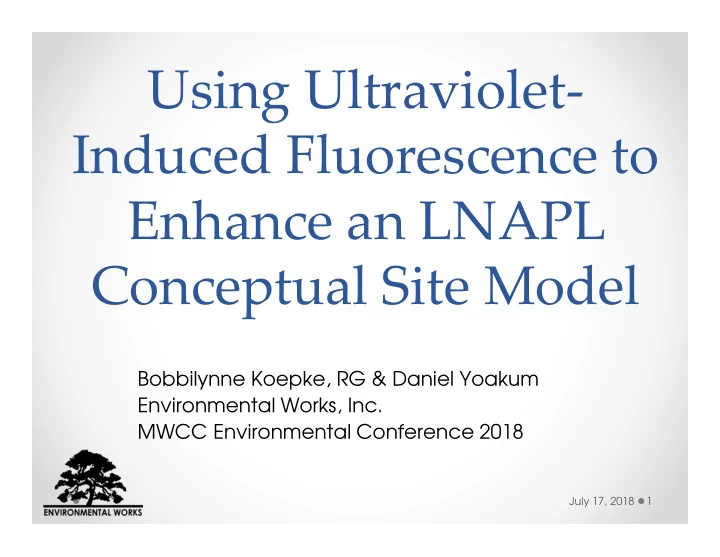

Using Ultraviolet- Induced Fluorescence to Enhance an LNAPL Conceptual Site Model Bobbilynne Koepke, RG & Daniel Yoakum Environmental Works, Inc. MWCC Environmental Conference 2018 July 17, 2018 1
Using Ultraviolet-Induced Fluorescence to Enhance an LCSM • Technology introduction and background • Technology Uses • Case Study o Background and Initial LCSM o LNAPL fluorescence work o Updated LCSM and outcome • Summary 2
Technology Introduction • LNAPL fluorescence 3 *photos courtesy of Geoprobe and Dakota Technologies
Technology Introduction • Fluorescence logging tools 4
Technology Introduction • DPT tooling 5
Technology Uses • Timely LNAPL characterization • Quickly document general soil type • Quicker understanding of LNAPL lateral distribution • Help select soil sample locations • Real-time field decisions • Enhance remedial design 6
Case Study 7
Case Study 8
Case Study 9
Case Study 10
Case Study 11
Case Study • LCSM Summary o Lithology is silty clay/loam that grades vertically to sand o Groundwater is present at 3-7 ft bls, which results in confining conditions for a majority of the time o Two documented gasoline releases o LNAPL mass is primarily present at 5-8 ft bls o Some mobile LNAPL is present, but not migrating o No risk from LNAPL at the site o LNAPL recovery efforts resulted in recovering approximately 200 gallons of LNAPL and nearly 5,000 gallons of impacted water 12
Case Study 13
Case Study 14
Case Study 15
Case Study 16
Case Study 17
Case Study 18
Case Study 19
Case Study #2 – Fuel Oil Site • Power Plant near Kansas City • Fuel discovered in onsite pond – old French drain 25 ft bgs • Limited excavation, line cleaning, and camera could not identify source • Large volume of underground pipelines and utilities 20
Case Study - OIP • EWI used in- house GPR with Line Trac to locate product lines and depths • Advanced OIP along the possible leaking lines 21
Case Study - OIP Footer Text 22
Case Study - OIP Same boring, different depths - Optical shows clean sandy fill @ 7.2 ft bgs - Fluorescence at 7.8 ft bgs 7/18/2018 23
Case Study - OIP Separate borings Top left shows optical • when fill around product line was encountered (no LNAPL) Bottom shows UV • fluorescence in fill material at 5.8 ft bgs 7/18/2018 24
Case Study - OIP • EWI was able to find general source area in 1 day • Borings advanced adjacent to OIP boreholes to collect soil samples and confirm results • OIP borings also ID’d diesel fuel in the soils along a water line corridor 25
Summary • LNAPL fluorescence logging is a proven technology with years of experience • Help understand LNAPL distribution in real-time • Get quick snapshot of soil lithology with EC sensor • Help target soil sampling horizons • Important part of LCSM • Direct remedial design and approach • Can be very cost effective tool in project lifecycle • EWI can implement with OIP and Geoprobe equipment 26
Questions? Bobbilynne Koepke, RG Daniel Yoakum Environmental Works, Inc. 417-890-9500 bkoepke@environmentalworks.com dyoakum@environmentalworks.com 27
Recommend
More recommend